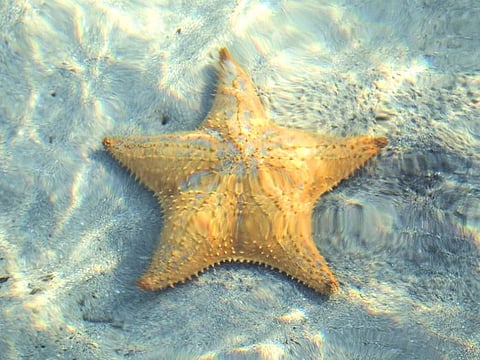How many arms do starfish have? If you said 'five,' you're wrong.
Advances in genetics are allowing researchers to probe the complexity of life on Earth

Pop quiz: How many arms do sea stars have?
The answer seems obvious: one, two, three, four, five. Five arms. Anyone who has stumbled across one splayed on the seashore knows this.
But if that is your answer, bad news: You're wrong. In new research published Wednesday, scientists detail how sea stars evolved into their distinct star shape, and it may have just upended everything commonly known about the animal's anatomy. The answer is stranger than anything most scientists expected.
Simply put, the sea star, also known as starfish, appears to be mostly just a head. Molecular analysis of its genes suggests its ancestors evolved to lose their trunk.
The study shows how advances in genetics are allowing researchers to probe the complexity of life on Earth like never before. In this case it's helped solve a centuries-old zoological mystery about one of the most puzzling creatures on the planet. Even the name "starfish" is misleading, since the animal isn't technically a fish.
"We call them arms of the starfish because we're used to thinking of the things that stick out of the body as arms and legs," said Daniel Rokhsar, a professor at the University of California at Berkeley who co-wrote the study in the journal Nature. "That's our own anthropomorphic perspective."
But this new research shows that for sea stars, "arm" is "a misused term," he added.
There were several hypotheses about how sea stars developed their distinct bodies, and "basically none of them match with the reality," said Laurent Formery, a developmental biologist at Stanford University who led the research.
Turning the sea star on its head
With most other animals, everything from a whale to a mouse, it's easy to tell which end is its head and which is its tail. Biologists call these creatures bilaterally symmetric, meaning they have left- and right-hand sides that mirror one another.
"Most of the animals we know and love have that form," Rokhsar said.
But sea stars and their relatives, such as sea urchins and sand dollars, are trickier. These animals, called echinoderms, have a fivefold symmetry, meaning their bodies can be divided into five equal sections.
Zoologists have long struggled to relate body plans of sea stars and other echinoderms with those of most other animals. Which part is the "head" and which is its "tail" was anyone's guess. Many scientists wrote off sea stars as headless animals.
"You see the echinoderms and they're like, 'Who ordered this?'" Rokhsar said.
Making the mystery all the more confounding is that sea stars, despite their strange appearance, aren't that distantly related to humans, sharing an ancestor 600 million years ago. Sea star larvae, like people, are actually bilaterally symmetric. Baby sea stars bob for weeks to months in the ocean before suddenly reconfiguring their bodies into their adult fivefold shape.
For their study, Formery and his team used two techniques to pinpoint how genes are expressed through the body of a sea star species called the bat star. One technique involved incubating a sea star in a fluorescent probe that clung to specific sections of RNA. The other involved slicing a sea star into thin pieces, sequencing the RNA in each slice and reconstructing the creature into a three-dimensional map on a computer.
Focusing on genes known to be associated with the head, torso and tail in other animals, the team discovered that sea stars are composed of cells that are, genetically speaking, almost entirely head.
As Thurston Lacalli from the University of Victoria in Canada put it in an accompanying perspective piece in Nature, the sea star is like a "disembodied head walking about the sea floor on its lips."
"It's an elegant and compelling study, with important implications for the evolutionary history of sea stars and other echinoderms," said Imran Rahman, a paleontologist at the Natural History Museum in London who was not involved in the research.
He added that paleontologists like himself now must comb through the rich fossil record of sea stars to figure out how it lost its torso. "Ultimately, this could enable us to uncover the sequence of evolutionary changes that gave rise to the head-like body plan," Rahman said.
Why five?
The research team was able to probe this long-standing question about the body of a sea star because of the plummeting cost and the increasing speed of sequencing genes.
"We didn't have the tools," said Christopher Lowe, another study co-author from Stanford. "We have just got to the point where we can address these questions in a way that was pretty difficult to do even five years ago."
Among the funders of the study are the Chan Zuckerberg Biohub in San Francisco, a medical science nonprofit funded by Facebook co-founder Mark Zuckerberg and his wife Priscilla Chan, as well as NASA, which is interested in how life may evolve on other planets.
The next step, the team said, is to study the body plans of sea urchins, sea cucumbers and other sea star relatives.
"No single species has all the answers," said Zak Swartz, a University of Chicago scientist who studies sea star development but was not involved in the most recent study.
"And a big open question remains: What is the origin of fivefold symmetry?" he added. "And why the number five?"
This article is part of Animalia, a column exploring the strange and fascinating world of animals and the ways in which we appreciate, imperil and depend on them.
Sign up for the Daily Briefing
Get the latest news and updates straight to your inbox


